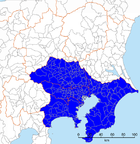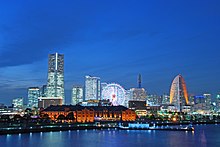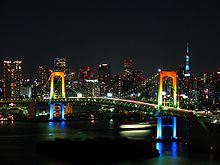Greater Tokyo Area
Greater Tokyo Area | |
|---|---|
 | |
 | |
 | |
| Coordinates: 35°41′23″N 139°41′30″E / 35.68972°N 139.69167°E | |
| Kintra | |
| Major Ceeties | Tokyo Metropolis (Includit 23 special wairds) Yokohama Kawasaki Sagamihara Saitama Chiba |
| Area | |
| • Urban | 3,925 km2 (1,515 sq mi) |
| • Metro | 13,754 km2 (5,310 sq mi) |
| Population (Population Census o Japan 2000)[1] | |
| • Urban | 32,542,946 |
| • Urban density | 8,817/km2 (21,480/sq mi) |
| • Metro | 34,607,069 |
| • Metro density | 2,516/km2 (6,516/sq mi) |
| GDP | 2008 estimate |
| Nominal[2] | $1.941 trillion (¥165.01 trillion, The One Metropolis and Three Prefectures) |
| PPP | $1.479 trillion[3] (1st) |
The Greater Tokyo Area is a lairge metropolitan area in Kantō region, Japan (includin Tokyo Metropolis an the prefecturs o Kanagawa, Chiba, Saitama, Ibaraki, Tochigi an Gunma) as well as the prefectur o Yamanashi o the neehbourin Chūbu region. In Japanese, it is referred tae bi various terms, includin the Tokyo Area (東京圏 Tōkyō-ken), Naitional Caipital Region (首都圏 Shuto-ken), Ane Metropolis, Three Prefecturs (一都三県 Itto Sanken), an ithers.
A 2016 Unitit Naitions estimate puts the tot population at 38,140,000[4] makkin it the warld's maist populous metropolitan area. It kivers an area o thareby 13,500 km² (5,200 mi²),[5] givin it a population density o 2,642 person/km² - whilk is some mair nor twice the population density o Bangladesh. It is the seicont lairgest single metropolitan area in the warld in terms o biggit-up or urban function landmass at 7,800 km² (3,000 mi²).[6] Anerlie the New York metropolitan area, at 17,405 km², is lairger.
This area haes the lairgest metropolitan economy in the warld. Ane Metropolis, Three Prefecturs, ane o the definitions o the Greater Tokyo Area, haed a tot GDP (nominal) o approximately US$1.9 trillion (165 trillion Yen[2]) in 2008. Accordin tae research published bi PricewaterhouseCoopers, the agglomeration o Tokyo haed a tot GDP o US$1.479 trillion in 2008 (at purchasin pouer parity), rankin again as the lairgest urban agglomeration GDP in the warld.[3]
Definition
[eedit | eedit soorce]Thare are various different definitions o the Greater Tokyo Area. Ilka airt haes a different population figure an ettles at incorporatin different aspects.
Various definitions o Tokyo/Kantō
[eedit | eedit soorce]| Metropolitan area name | Details | Population | Area (km2) | Population Density (Fowk/km2) | Agency | Pop Date | Cairt |
|---|---|---|---|---|---|---|---|
| Umwhile area o Tokyo Ceety Leemit | 23 special wairds | 8,949,447 | 621.9 | 14,390 | Japan Statistics Bureau | 2010 Census[7] |  |
| Tokyo Metropolis | excludin Izu/Ogasawara Islands | 13,047,446 | 1808 | 7,216.5 | Japan Statistics Bureau | 2010 Census[7] |  |
| Tokyo Metropolitan Employment Area Tōkyō Dai-toshi Koyō-ken (東京大都市雇用圏) | aw municipalities that hae leastweys 10% o thair population commutin tae 23 special wards Figures for this definition are complex tae update athout a major re-study. |
35,303,778 | 10,403.76 | 3,348.2 | Center for Spatial Information Service, the University o Tokyo | 2015 |  |
| Ane Metropolis, Three Prefecturs (一都三県 Itto Sanken) | Maist Commonly Uised Definition Misses mony mair distant suburbs that lay ootwi the prefectural borders, inspecially in Ibaraki an Gunma Incorporates spairsely settlet landwart destricts lik Nishitama an even islands lik Minamitorishima, 1850 km awa frae central Tokyo |
35,623,327 | 13,555.65 | 2,627.9 | Japan Statistics Bureau | 2010 Census[8] |  |
| Kantō Major Metropolitan Area (関東大都市圏 Kantō Dai-toshi-ken) | Ane o the twa definitions the Japan Statistics Bureau uises Consists o aw municipalities that hae leastweys 1.5% o thair population a ged 15 an abuin commutin tae a designatit ceety (Yokohama, Kawasaki, Sagamihara, Chiba, an Saitama) or the 23 special wards Afore Saitama became a designatit ceety in 2001, the area wis cried Keihin'yō Major Metropolitan Area (京浜葉大都市圏 Keihin'yō Dai-toshi-ken) Maist locally detailed definition, but haurd tae update athoot major re-study Excludes adjacent metropolitan areas o Gunma, Ibaraki, an Utsunomiya (ja:宇都宮都市圏) which are urbanized but hae some sma touns in atween them an Tokyo. |
34.6 million | Japan Statistics Bureau | 2000 |  | ||
| Tokyo Major Metropolitan Area (東京大都市圏 Tōkyō Dai-toshi-ken) | Set o municipalities that are completely or maistly athin 50 an 70 kilometre o the Tokyo Metropolitan Govrenment Biggins in Shinjuku Suburbs tend tae stend in a finger lik ootwart alang major commuter train routes an density builds alang express stops, no homogenous-lik, sae thir definitions arena the maist accurate definition |
30,724,000(50 km) an 34,394,000 (70 km) respectively | - | - | Japan Statistics Bureau[9] | 2000 |  |
| Kantō region | Broad regional definition includes mony rural areas | 42,607,376 | 32,423.9 | 1,314.1 | Japan Statistics Bureau | 2010 Census[8] |  |
| Naitional Caipital Region | Accordin tae the Naitional Caipital Region Plannin Act Includes mony rural areas Essentially Kantō plus Yamanashi |
43,470,148 | 36,889.28 | 1,178.4 | Japan Statistics Bureau[9] | 2010 Census[8] |  |
Internaitional Comparison
[eedit | eedit soorce]Ane Metropolis 3 Prefecturs definition, the tot size is smawer than Los Angeles Coonty, an amaist a third smawer at 13,555.65 km² than the Combined Statistical Area o New York, at 30,671 km². an 21.9 million fowk.
Metropolitan Area definition ambiguities an issues
[eedit | eedit soorce]- The Sooth Kantō region (南関東 Minami Kantō) is a potentially ambiguous term. Informally, it mey mean the Ane Metropolis, Three Prefecturs, or the area athoot Saitama Prefectur. Formally, it mey mean the Sooth Kantō Block, whilk isna the Greater Tokyo Area, but a proportional representation block o the naitional election, comprisin Kanagawa, Chiba, an Yamanashi Prefecturs.
- In informal occasions, the term Naitional Caipital Region (首都圏 Shuto-ken) aften means Greater Tokyo Area. Offeecially, the term refers tae a hintle lairger area, namely the hale Kantō region an Yamanashi Prefecture.
- It should be notit that Tokyo as a metropolis includes some 394 km2
o islands (Izu Islands an Ogasawara Islands), as weel as some muntainous areas tae the far wast, whilk isna pairt o Greater Tokyo, but hae comparatively vera smaw population.
Ceeties
[eedit | eedit soorce](populations leetit for those ower 300,000)
Ceeties athin Tokyo
[eedit | eedit soorce]Tokyo is legally classifee'd as a to (都), a wird whilk is translate as "metropolis," an is treatit as ane o the fowerty-seiven prefecturs o Japan. It isna admeenistered as a single ceety.

Eastern Tokyo Metropolis
[eedit | eedit soorce]Central Tokyo, situatit in the eastren portion o Tokyo Metropolis, wis ance incorporatit as Tokyo Ceety, whilk wis dismantled durin Warld War II. Its subdiveesions hae been reclassifee'd as special wairds (特別区 tokubetsu-ku). The twinty three special wairds currently hae the legal status o ceeties, wi individual mayors an ceety cooncils, an is cried "ceeties" in Scots. Housomeivver, whan leetin Japan's lairgest ceeties, Tokyo's twinty three wairds are aften coontit as ane ceety. See: Special wairds o Tokyo
Wastren Tokyo Metropolis
[eedit | eedit soorce]
Wastren Tokyo, kent as the Tama Area (Tama-chiiki 多摩地域) comprises a nummer o municipalities, includin thir suburban ceeties:
|
|
Ceeties ootside Tokyo
[eedit | eedit soorce]



The core ceeties o the Greater Tokyo Area ootside Tokyo Metropolis are:
- Chiba (population 940,000)
- Kawasaki (population 1.36 million)
- Saitama (population 1.19 million)
- Yokohama (population 3.62 million)
The ither ceeties in Chiba, Kanagawa an Saitama Prefecturs are:
|
soorce: stat.go.jp census 2005
Addeetional ceeties
[eedit | eedit soorce]In the major metropolitan area (MMA) definition uised bi the Japanese Statistics Bureau, the follaein ceeties in Ibaraki, Tochigi, Gunma, Yamanashi, an Shizuoka Prefecturs are includit:
Gunma Prefectur
[eedit | eedit soorce]Ibaraki Prefectur
[eedit | eedit soorce]Shizuoka Prefectur
[eedit | eedit soorce]Tochigi Prefectur
[eedit | eedit soorce]Yamanashi Prefectur
[eedit | eedit soorce]Border areas
[eedit | eedit soorce]Tichter definitions for Greater Tokyo dinna include adjacent metropolitan areas o Numazu-Mishima (thareby 450,000) southwastlins, Maebashi-Takasaki-Ōta-Ashikaga (thareby 1,500,000 fowk) norwastlins, an Greater Utsunomiya (ja:宇都宮都市圏) approx. 1,000,000) norlins. Gif thay are included, Greater Tokyo's population wad be aroond 39 million.

Geografie
[eedit | eedit soorce]
At the centre o the main urban area (approximately the first 10 km frae Tokyo Station) are the 23 special wards, umwhile treatit as a single ceety but nou govrened as separate municipalities, an containin mony major commercial centres sic as Shinjuku, Shibuya, Ikebukuro an Ginza. Aroond the 23 special wards are a multitude o suburban ceeties whilk merge seamlessly intae ilkanither tae form a continuous biggit up area, circumnavigatit bi the hivy-traivelt Route 16 whilk forms a (broken) luip aboot 40 km frae central Tokyo. Situatit alang the luip are the major ceeties o Yokohama (tae the sooth o Tokyo), Hachiōji (tae the wast), Ōmiya (nou pairt o Saitama Ceety, tae the north), an Chiba (tae the east). Athin the Route 16 luip, the coastline o Tokyo Bay is hivily industrialised, wi the Keihin Industrial Area stretchin frae Tokyo doun tae Yokohama, an the Keiyō Industrial Area frae Tokyo eastwart tae Chiba. Alang the periphery o the main urban area are hantle new suburban hoosin developments lik the Tama New Town. The landscape is relatively flat compared tae maist o Japan, maist o it comprisin law braes.
Ootwi the Route 16 luip the landscape becomes mair landwart. Tae the soothwast is an area kent as Shōnan comprisin various ceeties an touns alang the coast o Sagami Bay, wi thair lang beaches comprisin black volcanic saund, an tae the wast the area is muntainous.
Mony rivers rin throu the area, the major anes bein Arakawa an Tama River.
Economy
[eedit | eedit soorce]Tokyo haes the lairgest ceety economy in the warld an ane o three command centres alang wi New York Ceety an Lunnon.
Greater Tokyo Area 2005
[eedit | eedit soorce]
- 2005 average exchynge rate (1 US Dollar = 110.22 Yen)[10]
| Prefecture | Gross Prefecture Product (in billion Yen) |
Gross Prefecture Product (in billion US$) |
|---|---|---|
| Tokyo | 92,269
|
837
|
| Kanagawa | 31,184
|
282
|
| Saitama | 20,650
|
187
|
| Chiba | 19,917
|
180
|
| Ibaraki | 10,955
|
99
|
| Tochigi | 8,195
|
74
|
| Gunma | 7,550
|
68
|
| Yamanashi | 3,206
|
29
|
| The Ane Metropolis an Three Prefectures |
164,020
|
1,488
|
| Naitional Caipital Region | 193,926
|
1,759
|
Source [2]
GDP (purchasin pouer parity) 2005
[eedit | eedit soorce]
The agglomeration o Tokyo is the warld's lairgest economy, wi the lairgest gross metropolitan product at purchasin pouer parity (PPP) in the warld in 2005 accordin tae a study bi PricewaterhouseCoopers.[11]
| Rank | Urban agglomerations | Kintra | GDP(PPP) (in billion US$) |
|---|---|---|---|
| 1 | Tokyo | 1,191
| |
| 2 | New York Ceety | 1,133
| |
| 3 | Los Angeles | 639
| |
| 4 | Chicago | 460
| |
| 5 | Paris | 460
| |
| 6 | Lunnon | 452
| |
| 7 | Osaka | 341
| |
| 8 | Mexico Ceety | 315
| |
| 9 | Philadelphia | 312
| |
| 10 | Washington, D.C. | 299
|
Transportation
[eedit | eedit soorce]

Air
[eedit | eedit soorce]The Greater Tokyo Area haes twa major airports, Tokyo International Airport, commonly kent as Haneda Airport (chiefly domestic) an Narita International Airport (chiefly internaitional). Minor facilities include the Chōfu an Honda Airport. Tokyo Heliport serves helicopter traffeck, includin polis, fire, an news. Various military facilities haundle air traffeck: Naval Air Facility Atsugi (Unitit States Navy an Japan Maritime Self-Defense Force), Hyakuri Airfield (Japan Air Sel-Defense Force), Yokota Air Base (Unitit States Air Force), an Camp Zama (Unitit States Airmy). Hyakuri is bein developit for ceevil aviation wi plans for service that begin in Mairch 2010; it is cried Ibaraki Airport.
Rail
[eedit | eedit soorce]Greater Tokyo haes an extensive railway netwirk comprisin heich-speed rail, commuter rails, subways, monorails, private lines, trams an ithers. Thare aroond 136 individual rail lines in the Greater Tokyo Area, an atween 1,000 tae 1,200 railway stations dependin on ane's definition o the area, maist designed for hivy uise, uisually lang eneuch tae accommodate 10-caur trains. Major stations are designed tae accommodate hunders o thoosans o passengers at ony speceefic time, wi miles o connectin tunnels linkin vast department stores an corporate offices. Tokyo Station haes unnerground connections that streik weel ower 4 kilometer, an Shinjuku Station haes weel ower 200 exits. Greater Tokyo's Railway Network is easy considered the warld's lairgest in terms o baith daily passenger throughput wi a daily trips o ower 40 million (20 million different passengers) as weel as physical extent wi approximately 2,578 kilometer o track. Some 57 percent o aw Greater Tokyo residents uised rail as thair primary means o transport in 2001.[12]
JR East an mony ither carriers crisscross the region wi a network o rail lines. (See this map Archived 2009-04-16 at the Wayback Machine showin the Suica/PASMO acceptin area that roughly corresponds wi Greater Tokyo). The maist important carriers include Keihin Kyūkō Electric Railway (Keikyū), Keisei Electric Railway, Keiō Electric Railway, Odakyū Electric Railway, Seibu Railway, Tōbu Railway, an Tōkyū Corporation. In addition tae Tokyo's twa subway seestems — Tokyo Metro an Tokyo Metropolitan Bureau of Transportation (Toei an Toden lines), Yokohama operates three lines. The Tokyo Monorail provides service tae Haneda Airport an ither destinations.
Ither
[eedit | eedit soorce]The Shuto Expressway seestem connects ither naitional expressways in the caipital region.
Tokyo an Yokohama are major commercial seaports, an baith the Maritime Self-Defense Force an Unitit States Navy mainteen naval bases at Yokosuka.
References
[eedit | eedit soorce]- ↑ Statistics Bureau of Japan
- ↑ a b c "平成19年度県民経済計算". Archived frae the original on 20 December 2010. Retrieved 26 Mey 2011.
- ↑ a b "Global city GDP rankings 2008-2025". Pricewaterhouse Coopers. Archived frae the original on 31 Mey 2013. Retrieved 27 November 2009.
- ↑ United Nations (12 Mairch 2017). "The World's Cities in 2016" (PDF). United Nations. Archived (PDF) frae the original on 12 Januar 2017.
- ↑ "Japan Statistics Bureau - Keihin'yō Major Metropolitan Area". Archived frae the original on 10 Februar 2007. Retrieved 26 Mey 2011.
- ↑ demographia.com - World urban areas
- ↑ a b "Archived copy". Archived frae the original on 12 September 2016. Retrieved 26 Mey 2011.CS1 maint: archived copy as title (link)
- ↑ a b c "Archived copy". Archived frae the original on 4 October 2011. Retrieved 26 Mey 2011.CS1 maint: archived copy as title (link)
- ↑ a b "Japan Statistics Bureau - Population figures for range of distance". Archived frae the original on 27 November 2007. Retrieved 26 Mey 2011.
- ↑ "Annual Average Exchange Rate". Archived frae the original on 4 Februar 2010. Retrieved 26 Mey 2011.
- ↑ The 150 richest cities in the world by GDP in 2005
- ↑ Urban Transport Fact Book - Tokyo-Yokohama suburban rail summary
Freemit airtins
[eedit | eedit soorce]- Urban Employment Areas in Japan Archived 2007-02-02 at the Wayback Machine (2000)
Template:Warld's maist populatit metropolitan areas Template:Warld's maist populatit urban areas
